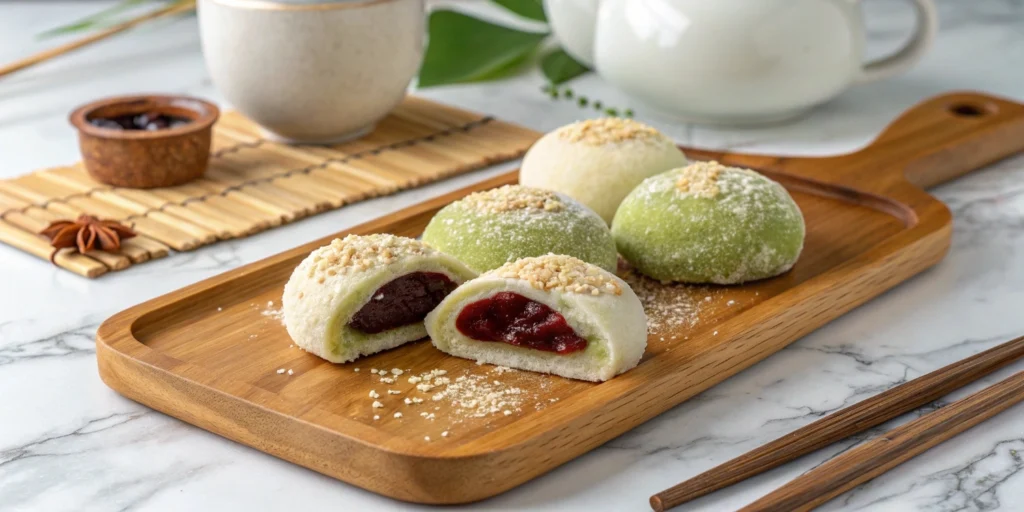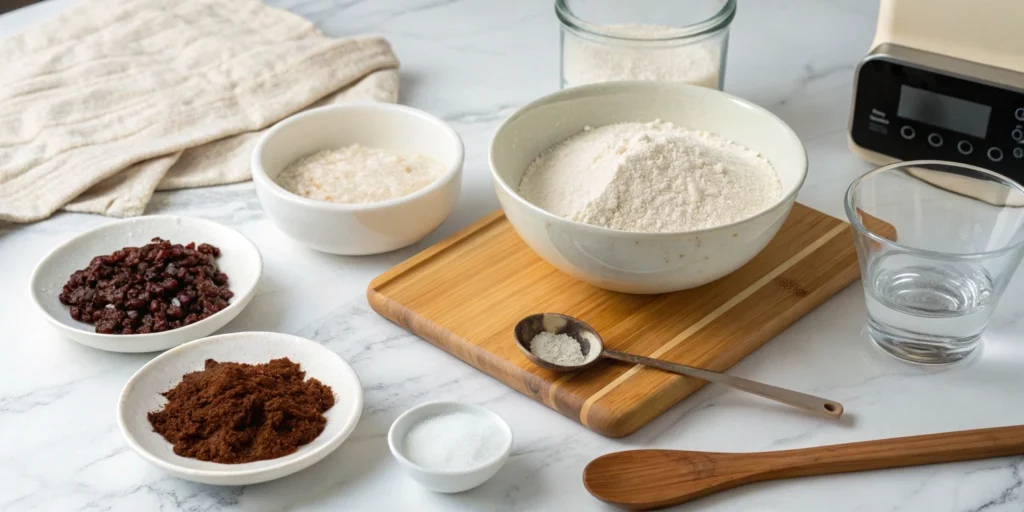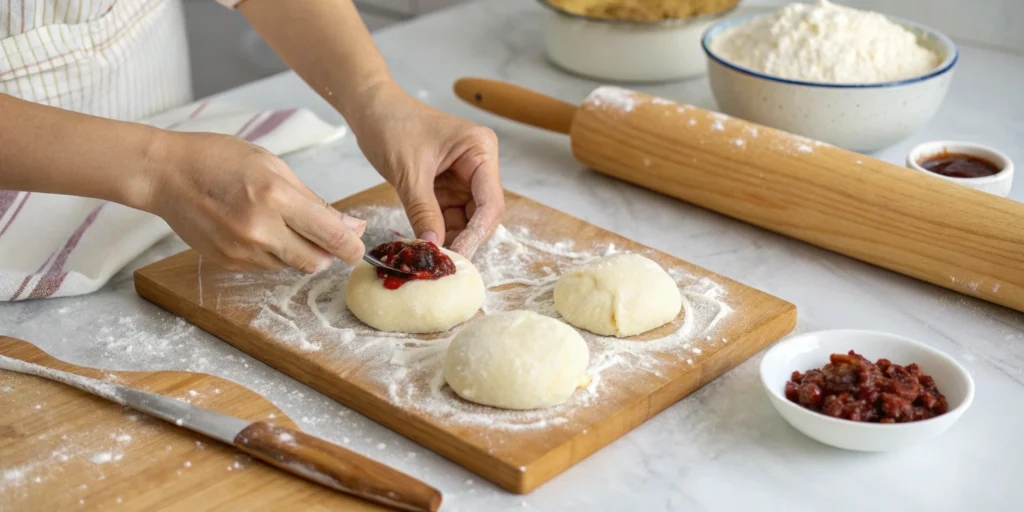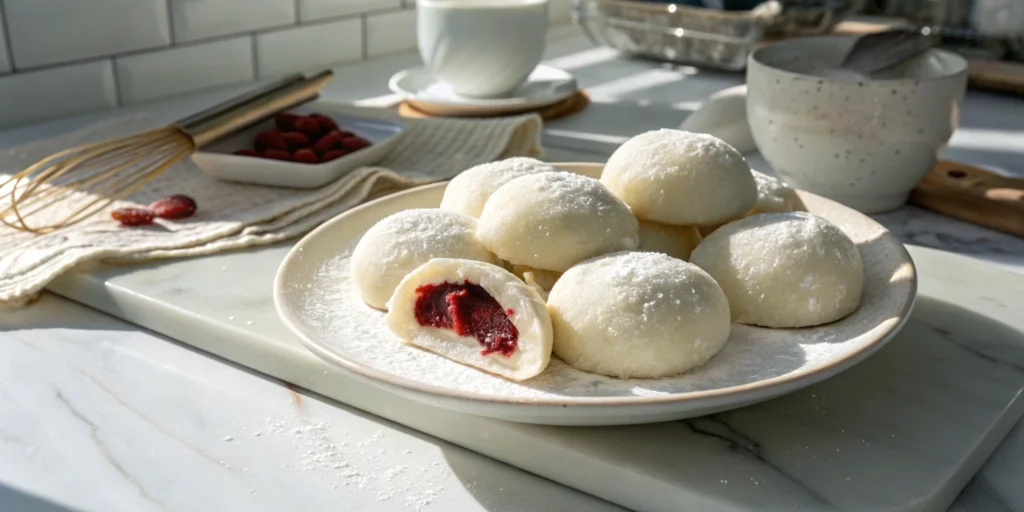
Table of Contents
Korean mochi, known as chapssaltteok (찹쌀떡), is a beloved treat that has been enjoyed for generations. This chewy, subtly sweet delight is often shared during special moments, bringing comfort and nostalgia with each bite. Unlike its Japanese counterpart, which sometimes features a softer texture, Korean mochi has a firmer chew that perfectly complements its fillings.
You may have tried the traditional red bean mochi, but there’s so much more to explore. In this article, you’ll learn how to craft three unique versions of Korean mochi, each offering a distinct flavor twist. Whether you prefer the classic taste of sweet red bean, the earthy bitterness of matcha paired with white chocolate, or the nutty richness of sesame and peanut, these variations will satisfy your cravings.
What Makes Korean Mochi Unique?
Mochi has been a staple in many East Asian cultures, but Korean chapssaltteok holds its own identity. It’s often eaten as a celebratory snack, especially during birthdays and national holidays. The combination of glutinous rice flour and a sweet filling creates an irresistible contrast of textures.
Unlike Western desserts that rely on butter and heavy cream, mochi delivers a satisfying chew with minimal ingredients. The key is glutinous rice flour, which gives it the perfect stretch without the need for additional thickeners.
Essential Ingredients and Tools for Perfect Mochi
To create the best Korean mochi at home, you’ll need a few essential ingredients and tools:

Base Ingredients for the Mochi Dough
- Glutinous rice flour (1 cup) – Also labeled as sweet rice flour, this is the key to achieving the signature chewiness.
- Sugar (2 tablespoons) – Adds a touch of sweetness to the dough.
- Water (3/4 cup) – Helps form the dough’s structure.
- Cornstarch or potato starch – Prevents sticking when shaping the mochi.
Common Tools
- Microwave-safe bowl – Speeds up the cooking process.
- Wooden spoon or spatula – Makes kneading easier when the dough is hot.
- Plastic wrap – Retains moisture while cooking.
- Rolling pin (optional) – Useful for flattening certain variations.
Inspired Korean Mochi: 3 Irresistible Variations
Each of these mochi variations brings a new twist to the traditional recipe. You can experiment with different flavors and fillings to create a treat that matches your taste preferences.

1. Classic Red Bean Mochi (Chapssaltteok)
The timeless favorite, red bean mochi, remains a staple in Korean homes. The smooth, slightly earthy sweetness of red bean paste pairs beautifully with the chewy mochi exterior.
Ingredients
- Glutinous rice flour (1 cup)
- Sweetened red bean paste (1/2 cup)
- Sugar (2 tablespoons)
- Water (3/4 cup)
- Cornstarch for dusting

Instructions
- In a microwave-safe bowl, mix glutinous rice flour, sugar, and water until smooth.
- Cover with plastic wrap, leaving a small vent, and microwave for 1 minute. Stir and repeat for another minute until the mixture turns translucent.
- Knead the dough with a spatula until it becomes elastic.
- Divide the dough into equal portions and flatten each piece.
- Place a spoonful of red bean paste in the center and carefully wrap the dough around it, sealing the edges.
- Dust with cornstarch to prevent sticking and serve.
2. Matcha White Chocolate Mochi
A modern take on the classic, this variation infuses the rich bitterness of matcha with the creamy sweetness of white chocolate.
Ingredients
- Glutinous rice flour (1 cup)
- Matcha powder (1 tablespoon)
- White chocolate chips (1/2 cup)
- Sugar (2 tablespoons)
- Water (3/4 cup)
- Cornstarch for dusting
Instructions
- Add matcha powder to the glutinous rice flour and sugar before mixing in water.
- Microwave the mixture in one-minute intervals, stirring in between, until the dough becomes sticky and translucent.
- Knead while warm until smooth.
- Flatten portions of the dough and place a few white chocolate chips inside.
- Wrap and seal the mochi, dusting with cornstarch before serving.
3. Sweet Sesame Peanut Mochi
This variation offers a nutty, aromatic profile with a combination of ground sesame seeds and peanut butter.
Ingredients
- Glutinous rice flour (1 cup)
- Toasted sesame seeds (1/4 cup)
- Peanut butter (1/4 cup)
- Sugar (2 tablespoons)
- Water (3/4 cup)
- Cornstarch for dusting
Instructions
- Blend sesame seeds and peanut butter to create a smooth filling.
- Prepare the mochi dough by mixing the glutinous rice flour, sugar, and water, microwaving in short bursts until fully cooked.
- Knead until smooth and divide into portions.
- Flatten each portion and fill with the sesame peanut mixture.
- Seal and dust with cornstarch before serving.
Expert Tips for the Best Mochi
- Use fresh glutinous rice flour – Stale flour can affect the chewiness.
- Knead while warm – This ensures a smooth and elastic dough.
- Don’t overcook – Overheating can cause the dough to harden too quickly.
- Experiment with fillings – Chocolate, fruit preserves, or nut spreads make excellent alternatives.
How to Store Your Mochi Properly
Mochi tastes best when fresh, but if you need to store it:
- Room temperature – Store in an airtight container for up to a day.
- Refrigeration – Keeps for up to 3 days, but may become firmer.
- Freezing – Wrap individually in plastic wrap and freeze for up to a month. Thaw before eating.
Frequently Asked Questions About Korean Mochi
Is Korean mochi gluten-free?
Yes! Since it’s made from glutinous rice flour, it contains no gluten.
Can I make mochi without a microwave?
Yes! You can steam the dough for about 10-15 minutes instead.
Why is my mochi too sticky?
It’s normal for mochi to be sticky, but dusting with cornstarch or potato starch will help.
Can I use different fillings?
Absolutely! Feel free to experiment with Nutella, fruit preserves, or custard.
Conclusion
Making Korean mochi at home is a rewarding experience that allows you to customize flavors and fillings to your liking. Whether you stick to the classic red bean, embrace the matcha white chocolate twist, or enjoy the nutty sesame peanut variety, each bite is guaranteed to satisfy. Now that you have these recipes, why not try making your own batch and share it with family and friends?
